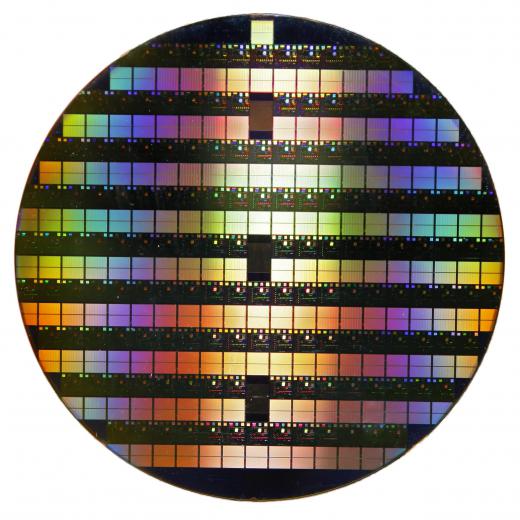What is a Dopant?
 Mary McMahon
Mary McMahon
A dopant is a substance which is added to a crystal lattice with the intention of changing its conductive properties. The term is most widely used in the chip manufacturing industry, where dopants are added to the silicon and germanium wafers used in the manufacture of computer chips. Other crystal lattices including those used in the manufacture of some optical equipment are also doped, however. Many dopants are extremely toxic, leading to widespread pollution in factories which fail to control their chemicals. Silicon Valley, for example, is heavily contaminated with the remains of chip manufacture.
A dopant works by altering the number of free electrons in a crystal lattice, thereby making it more conductive. In the example of silicon, the element typically forms a uniform crystal lattice in which each atom bonds to four neighbors. When a dopant with five bonding electrons is introduced, the result is free electrons, creating a negative charge. A dopant with three bonding electrons may be introduced to make holes in the lattice, creating a positive charge.

Boron, phosphorous, antimony, and arsenic are some common examples of dopants. Typically, a silicon wafer is coated in the dopant and then heated to encourage chemical bonding between the dopant and the silicon. After the wafer is cooled, the atoms will have rearranged to yield a more electrically conductive wafer which can be broken up for use in transistors and diodes, among other things.
A dopant basically represents an impurity within a crystal matrix. There are numerous uses for dopants; artificial gemstones, for example, may include a dopant so that they can be identified as laboratory-grown rather than natural. The doping process can also be used to change the refractive index of a substance, which is useful in some fields of optics. Solid state lasers, for example, include a crystal “host” which has been doped.
The term “doping” is also used to refer to a type of lacquer which is applied to fabric coated aircraft. The dope tightens the skin, providing protection and ensuring that the skin stays rigid during flight. Aircraft dope is highly flammable and extremely toxic, which was a major issue during the Second World War, when fabric coated aircraft were used in combat. Airplane dope is usually dyed so that it will be readily visible as it is being applied, ensuring that it will coat the aircraft evenly.
AS FEATURED ON:
AS FEATURED ON:











Discuss this Article
Post your comments